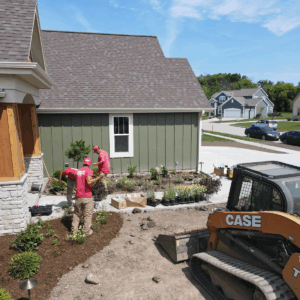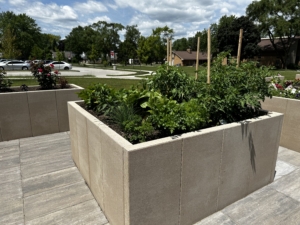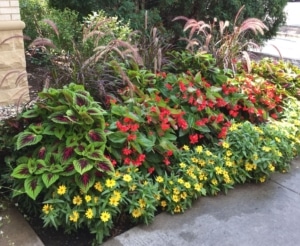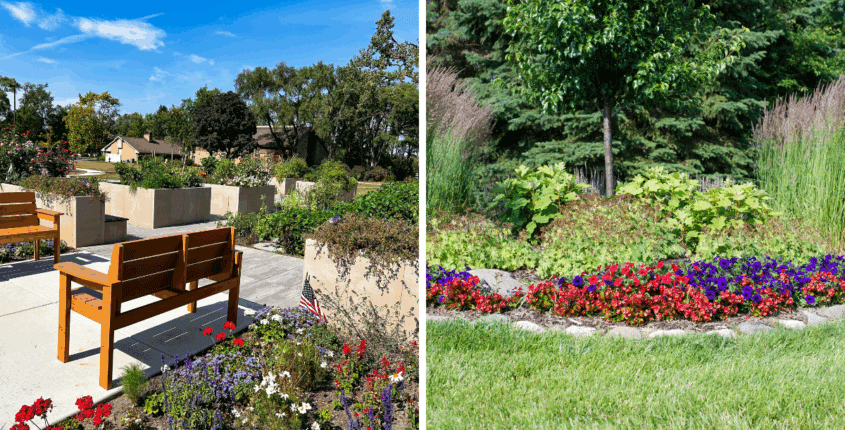Raised Garden Beds vs. In-Ground Planting: Which Works Best for Your Space?
Each year, as Elm Grove prepares for its Fourth of July fireworks, cars wind through quiet neighborhoods on the way to the park. Along the route, something else stands out — the gardens. By early summer, they seem to have transformed overnight.
What was bare soil in May is now full of color and texture: tomato vines climbing trellises, herbs nestled in raised beds, and wildflowers softening backyard fences. Every yard offers its own version of what it means to grow something well.
Some homeowners prefer the structure and simplicity of raised beds. Others work directly with the land, planting into the soil that’s been there for generations. Across southeastern Wisconsin, both methods have earned a place in local landscapes for good reason.
If you’re planning a new garden or expanding what you already have, your layout matters. It influences how your garden functions, what you can grow, and how much you’ll enjoy spending time in it.
What’s the Difference Between Raised Garden Beds and In-Ground Planting?
When planning a garden, one of the first decisions to make is how you’ll grow your plants. Two of the most popular methods are raised garden beds and in-ground planting. Each offers unique benefits and challenges, and the right choice depends on your space, goals, and soil conditions.
Let’s take a closer look at how each method works.
Raised Garden Beds Explained
Raised garden beds are freestanding structures built above ground level. Gardeners typically fill them with high-quality soil blends that match their planting needs.
These beds are often built with:
- Natural wood (such as cedar or redwood): Naturally rot-resistant and affordable, making it a popular DIY option.
- Galvanized metal panels: Extremely durable and long lasting, with a modern look that resists rot and pests
- Recycled composite boards: Made from recycled materials and designed to resist warping, cracking, and rot over time.
- Stone or masonry edging: Heavy-duty and permanent, offering a classic look and excellent insulation for soil.
Raised beds give you more control over:
- Soil composition and drainage
- Weed management
- Garden layout and spacing
They also improve accessibility, especially for gardeners who prefer not to kneel or bend. Because the soil sits above ground, it warms up faster in spring and dries out more quickly after rain. That makes it easier to manage planting schedules and moisture levels. This method is suitable for gardens with poor or compacted native soil. It also suits small yards, patios, or any space where a tidy, organized layout is preferred.
In-Ground Planting Explained
In-ground planting involves growing directly in the earth without raised borders or imported soil. This traditional method uses the existing soil on your property and typically begins with soil testing and preparation.
 Ground preparation begins with:
Ground preparation begins with:
- Tilling to break up compacted soil
- Adding compost or organic matter to improve texture and fertility
- Adjusting pH or nutrients based on soil test results
This method supports deep-rooted plants, allowing your garden to follow the natural contours of the landscape. It also works well for large garden beds where raised structures may not be practical.
In-ground planting is a good choice if you:
- Have access to healthy native soil or are willing to amend it
- Want to grow crops that require more root depth or horizontal space
- Prefer a natural look that blends into the surrounding landscape
- Are planning a larger garden that would be costly to build as raised beds
Although it may involve more physical labor at the start, in-ground planting offers long-term flexibility and room to scale. It remains one of the most cost-effective and traditional approaches to gardening, especially for expansive spaces.
Pros and Cons of Raised Garden Beds
Raised beds support intensive planting styles, such as square-foot gardening, making them ideal for maximizing yields in small spaces.
Loose, well-drained soil allows crops to grow closer together without competing for nutrients.
They also help with pest and disease control. The defined structure contains soil more effectively and makes it easier to install protective barriers, such as mesh or row covers.
On the downside, raised beds come with higher upfront costs due to the materials and construction required. They’re also harder to expand or move once installed.
In hot, dry weather, raised beds may require more frequent watering since they can lose moisture from all sides.
Pros and Cons of In-Ground Gardening
In-ground gardens offer long-term flexibility with minimal structural upkeep. There’s no need to maintain frames, and you can expand planting areas as your garden grows.
This method also supports a healthy ecosystem. Native microbes, earthworms, and beneficial fungi thrive in undisturbed soil, helping to improve long-term soil health and biodiversity.
However, in-ground beds can suffer from compaction, especially in clay-heavy soils or high-traffic areas. Poor drainage may lead to stunted growth or root issues if the soil isn’t well-maintained.
Weed control is also more demanding. Even with mulching and regular care, native soil tends to produce more persistent weed growth than contained raised beds.
Best Plants for Raised Beds and In-Ground Gardens
Wisconsin’s short growing season, cool spring temperatures, and varied soil conditions make it especially important to choose the right plants for your garden type.
Some crops grow best in the controlled soil of raised beds, while others thrive in the open layout of an in-ground plot.
Best Plants for Raised Beds
 Raised beds warm quickly in spring and offer excellent drainage, which benefits crops that prefer consistent moisture and nutrient-rich soil.
Raised beds warm quickly in spring and offer excellent drainage, which benefits crops that prefer consistent moisture and nutrient-rich soil.
Recommended plants for Wisconsin raised beds include:
- Leafy greens: lettuce, spinach, Swiss chard, arugula
- Cool-season herbs: parsley, cilantro, dill, thyme
- Compact root vegetables: radishes, beets, turnips, green onions
- Warm-season vegetables (with proper spacing and support): cherry tomatoes, bell peppers, bush beans
- Fruits: strawberries (especially June-bearing or everbearing varieties suited for the region)
These crops respond well to the loose, amended soil and predictable watering conditions raised beds can provide, especially in early or late parts of the growing season.
Best Plants for In-Ground Gardens
In-ground beds are ideal for larger plants or crops that require more space to spread out or develop deep roots. Wisconsin’s well-drained loam and clay-loam soils work well for many staple crops once properly amended.
 Recommended plants for Wisconsin in-ground gardens include:
Recommended plants for Wisconsin in-ground gardens include:
- Large vegetables: sweet corn, potatoes, pumpkins, squash
- Sprawling vines: cucumbers, melons (especially Minnesota Midget or other short-season types)
- Storage crops (crops that store well for weeks/months without losing quality): cabbage, carrots, rutabaga
- Perennials and ornamentals: rhubarb, asparagus, daylilies, native grasses
These plants benefit from the extra space and deeper rooting potential that in-ground planting allows. Many of them also tolerate the heavier soil types found throughout much of the state.
Choosing the Best Garden Type for Your Landscape
The right garden style depends on your goals, available space, and level of commitment.
Raised beds are well-suited for smaller spaces, modern layouts, and gardeners who want more control over their soil and structure. They’re an excellent choice for intensive planting and easy maintenance.
In-ground gardens are better suited for larger spaces, deep-rooted or sprawling crops, and those who are comfortable with ongoing soil management. They offer flexibility and long-term scalability.
Some homeowners even combine both methods to strike a balance between productivity, aesthetics, and cost.
Choose the Garden That’s Right for Your Needs with Help from American Landscape
Every yard is different, and your garden should reflect that. Whether you prefer the structure of raised beds or the openness of in-ground planting,
Contact us today to schedule a consultation and start building your ideal garden.

